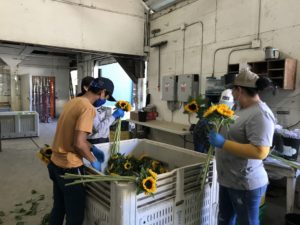
When most people think of summer crops, often the ones that come to mind are tomatoes, eggplant, and melons, but a key crop that often goes forgotten is sunflowers. We grow a lot of sunflowers and it’s not just us; they’re the sixth most valuable crop in Yolo County, grown on over 20,000 acres. Driving around the County right now, you’ll see countless fields of sunflowers all in bloom. Almost all of those fields of sunflowers aren’t harvested fresh; they are grown to be hybrid seed stock that will be sent around the world to be planted for oil. Unlike the fields for seed, our sunflowers are for cut flowers, for folks like you to bring into your home! Last year we harvested over 15,000 bunches of sunflower from May through October, with many more heads going into mixed bouquets. They’re a significant summer crop for us, thus worthy of a deep dive in the Beet.

At Full Belly, Amon is in charge of sunflowers. On average he plants about a quarter acre (three beds) of sunflowers every five days; each bed has two lines of seeds for a total of six lines. Usually one bed is a variety called Vincent’s Choice, at least one line of Zohar, and the rest are a mixture of several other varieties. Vincent’s Choice is a classic sunflower (yellow petals with a brown interior) and a solid choice for its disease resistance, fast growth (less time in the ground means they use less water!), and uniform flowering. This year we’re also trying out some new varieties from Sunflower Selections in Woodland, including several of their ProCut series in multiple colors. All of our sunflowers are single-stemmed (as opposed to branching, which are popular in home gardens), hybrid seeds, and pollenless, meaning less mess for our customers and no problems with any neighboring farms growing sunflower for seed.


We have sunflower growing almost down to a science. We pre-irrigate, remove weeds, plant the seeds, the seeds germinate in about six days, we cultivate once or twice, sprinkle irrigate, cultivate one more time, put down drip tape, and then come back to harvest. Sunflowers grow fast; about 55-75 days after planting, we have six-foot tall flowers to harvest. Sunflowers may be much less labor-intensive to grow than a crop like tomatoes, but they are a lot of work to harvest, bunch, and package. The sunflower harvesting crew walks through the fields cutting big armfuls with harvest knives and these flowers are immediately placed into buckets of water inside large macrobins on a trailer. They’ll harvest a planting of sunflowers two, maybe three, times before it gets mowed. To handle these armfuls of sunflowers, long sleeves and gloves are a must – sunflowers are very itchy and sticky. When full, the bins are brought back to the shop where the flowers are bunched, the bottoms are cut again, and they are put in buckets of water. For some customers, these buckets go into flower boxes. At the end of the day, the buckets and boxes are loaded onto the trucks to be delivered the next day.

This process sounds like a well-oiled machine, but like almost all of the machines at the farm, it sometimes breaks. Despite our best efforts to have one succession of sunflowers lead into the next, it doesn’t always happen that way and the steady stream of sunflowers can be a flood followed by a trickle, usually caused by the weather. Recently the weather has been incredibly variable; it was in the 70s and raining last weekend, then around 100 Thursday through Saturday. These big swings will invariably mean too many sunflowers one week and too few the next. But as with all other curve balls in farming, we’ll adapt and adjust and find them a good home.


-Elaine Swiedler, CSA Manager
